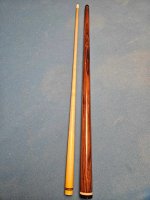You are using an out of date browser. It may not display this or other websites correctly.
You should upgrade or use an alternative browser.
You should upgrade or use an alternative browser.
Show your true Merry Widow and opinion of play!
- Thread starter Shooter08
- Start date
Biloxi Boy
Man With A Golden Arm
I thought I understood the OP's proposition, but many of the responses prove (as my wife tells me all the time) I don't know a #(%*!)# thing.
I thought I understood the OP's proposition, but many of the responses prove (as my wife tells me all the time) I don't know a #(%*!)# thing.
we're never to old to learn
Does the one on the right count?
My playing cue is a Meucci SS-15, 19 oz, antique stained maple butt, Irish linen wrap that is lacquered (I like that it has a feel of a wrapless cue with the aesthetics of a wrapped cue), 11.8 CF shaft. It is a stiff cue with an effortless hit.

My playing cue is a Meucci SS-15, 19 oz, antique stained maple butt, Irish linen wrap that is lacquered (I like that it has a feel of a wrapless cue with the aesthetics of a wrapped cue), 11.8 CF shaft. It is a stiff cue with an effortless hit.
If the the whole butt is one piece of wood than I would think you meet the requirements as the butt cap and joint appear to have the rings imposed and they are not separate.Does the one on the right count?
My playing cue is a Meucci SS-15, 19 oz, antique stained maple butt, Irish linen wrap that is lacquered (I like that it has a feel of a wrapless cue with the aesthetics of a wrapped cue), 11.8 CF shaft. It is a stiff cue with an effortless hit.
View attachment 752908
here is my player cue, a simple ebony/ black and white ebony merry widow made by Dave Barenbrugge I bought a decade ago , and that's still my player cue , now got some battle scars , but that's a player cue ... (thanks again to Martin Bick , you know why...)



Where is it written that a 'merry widow' has to be a one-piece butt? Virtually every MW i've seen used a multi piece butt section. My favorite were the Judd mw's. Fkng gorgeous cues. https://forums.azbilliards.com/threads/judd-cues-wts-wtt.293456/
Where is it written that a 'merry widow' has to be a one-piece butt? Virtually every MW i've seen used a multi piece butt section. My favorite were the Judd mw's. Fkng gorgeous cues. https://forums.azbilliards.com/threads/judd-cues-wts-wtt.293456/
I dont have a copy so i cannot confirm the details, but apparently the billiards encyclopedia mentions this on page 197 (Post number 10 talks about it in the link). I've also seen multiple other persons mention this specific reference through the years.
I thumbed through the "BILLIARD ENCYCLOPEDIA" & on page 197, it says that the BRUNSWICK catalog from 1923-24, has a "MERRY WIDOW" model cue. It has no points or inlays. It does have a wrap. By the way the word "point" in those days referred to the ferrule...JER
billiards_watch
Well-known member
Mezz EC9
I like how they play. Just no nonsense beautiful wood and shoots well.
I like how they play. Just no nonsense beautiful wood and shoots well.
Then i guess all the multi-piece butt MW's made were not MW's?? C'mon man.I dont have a copy so i cannot confirm the details, but apparently the billiards encyclopedia mentions this on page 197 (Post number 10 talks about it in the link). I've also seen multiple other persons mention this specific reference through the years.
I thumbed through the "BILLIARD ENCYCLOPEDIA" & on page 197, it says that the BRUNSWICK catalog from 1923-24, has a "MERRY WIDOW" model cue. It has no points or inlays. It does have a wrap. By the way the word "point" in those days referred to the ferrule...JER
Multiple piece butts should be referred to as a plain jane, not merry widow. At least that my understanding. I don't really care about semantics too much, but this one caught my interest because I always thought a merry widow was any plain butt, and then I found that comment!Then i guess all the multi-piece butt MW's made were not MW's?? C'mon man.
Very nice!It doesn't get much simpler than this. It plays great.
2 pieces of wood. Rubber on one end, plastic and leather on the other with G10 in the middle.
Oil finish



That thing needs a brown bumper IMHO.
